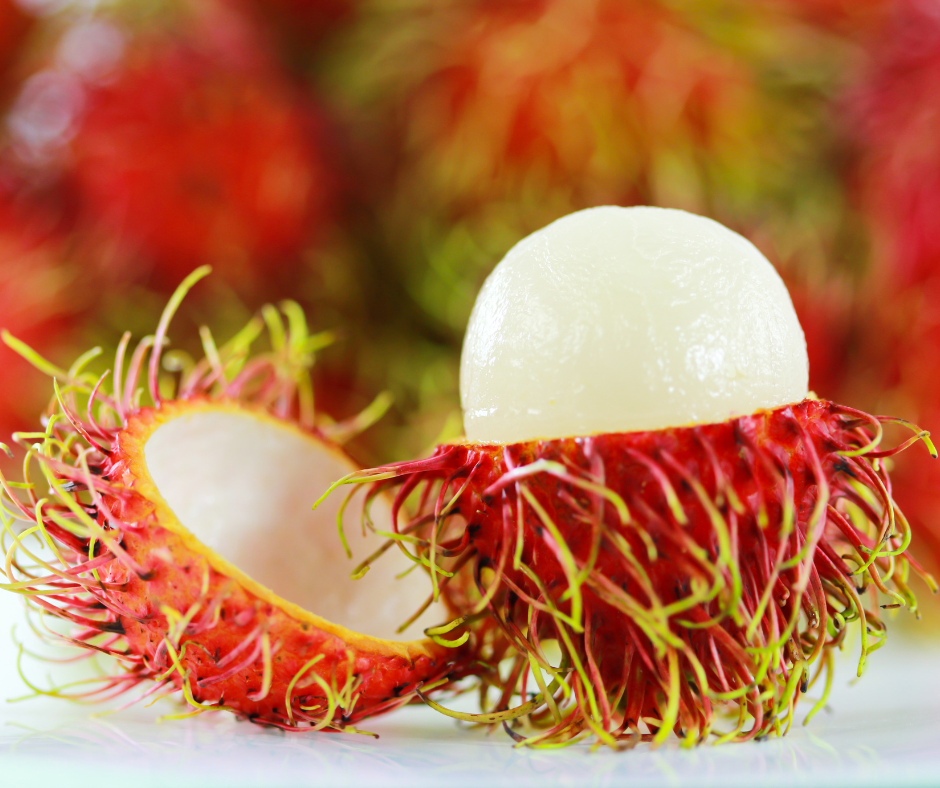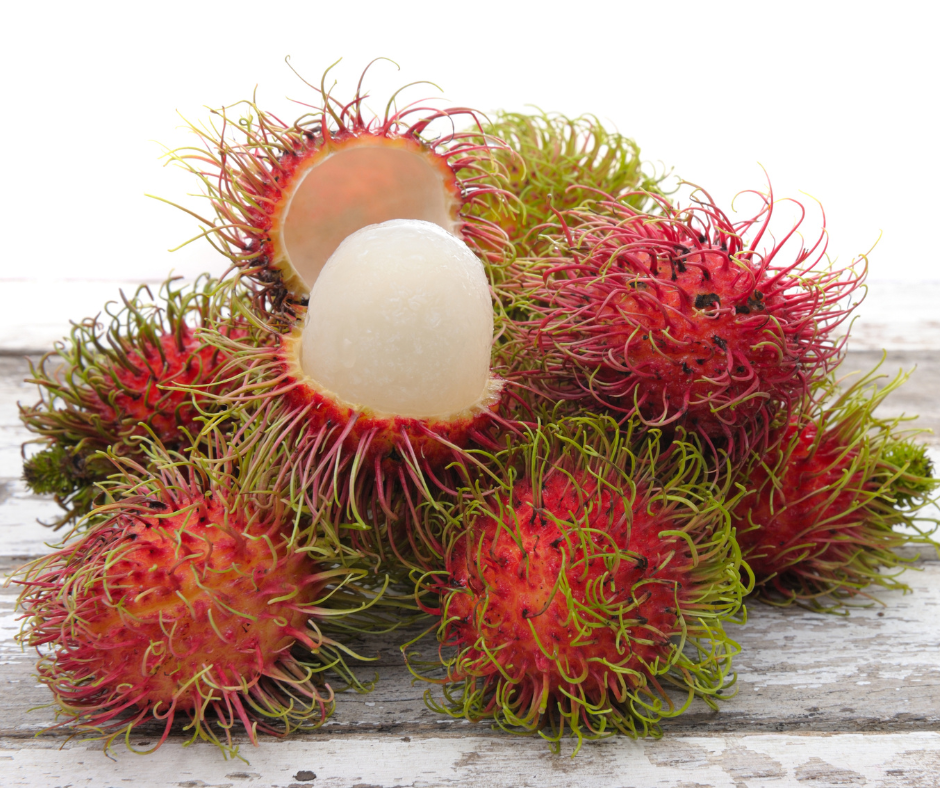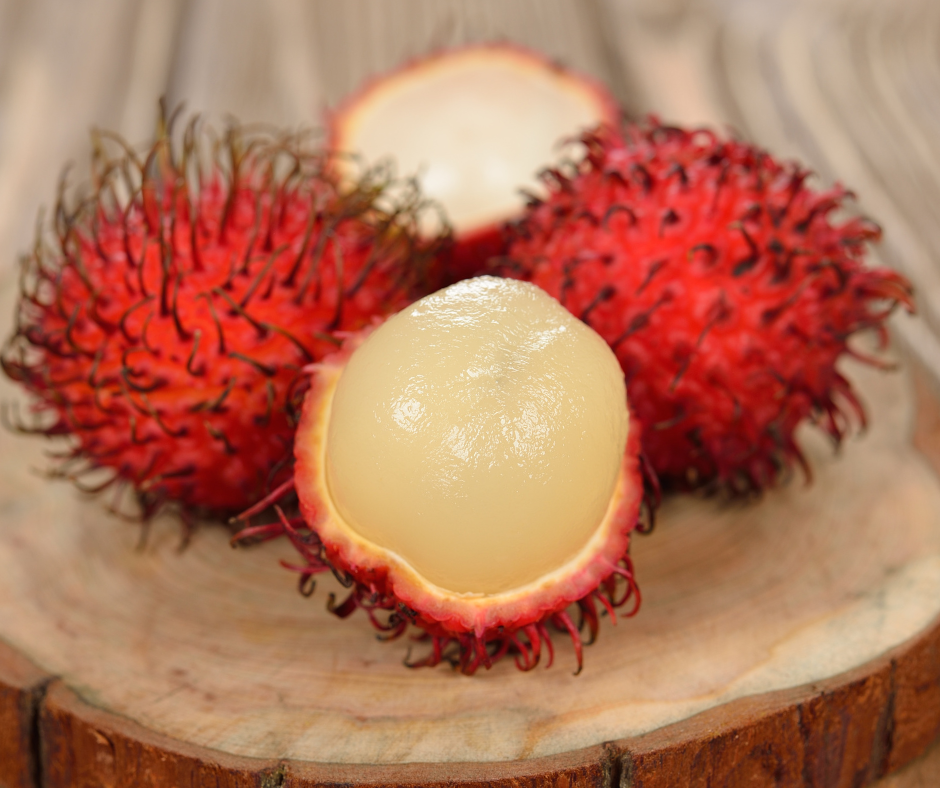Introduction
Rambutan is a delicious, exotic fruit native to Southeast Asia but has gained popularity worldwide for its unique appearance and sweet taste. Its juicy, tender flesh and creamy flavor have made it a beloved fruit throughout the region. This blog will help you thoroughly explore ‘What Does Rambutan Taste Like?‘.
The Popularity Of Rambutan
The popularity of rambutan stems from its flavorful taste and unique appearance. Its hairy, spiky exterior looks intimidating at first, but once peeled, the fruit reveals a soft white interior that is juicy and refreshing. Rambutan’s sweet and creamy taste has often been compared to that of a green grape with floral undertones and a touch of acidity.
Rambutan’s popularity has grown in recent years, and it can now be found in many supermarkets and specialty stores worldwide. Many chefs also incorporate rambutan into their dishes, adding its distinct tropical flavor to salads, cocktails, and desserts.
What Is Rambutan?
Rambutan is a tropical fruit that belongs to the Sapindaceae family, along with other fruits such as lychees and longans. The name “rambutan” is derived from the Malay word for “hair,” which refers to the fruit’s hairy exterior. The fruit is typically grown in tropical regions and varies in size and color depending on the variety.
To eat rambutan, one must remove the spiky exterior by making a small incision and peeling it away. The white flesh inside can be eaten raw or used to flavor various dishes. It is a great source of vitamin C and other antioxidants, making it a healthy addition to any diet.
In conclusion, rambutan’s popularity has grown significantly due to its unique appearance and delicious taste. Its juicy, refreshing flesh and sweet flavor have made it a beloved fruit worldwide. With many health benefits and culinary possibilities, rambutan is a fruit worth trying.
Appearance Of Rambutan
Exotic Appearance
Rambutan, a tropical fruit native to Southeast Asia, has gained popularity worldwide, thanks to its intriguing and exotic appearance. Its hairy, spiky exterior, which looks like a small sea urchin, is firm and comes in shades of pink, green, and bright red, making it a visually appealing fruit.
Rambutan Skin And Texture
The firm, hairy exterior of the rambutan serves as a protective layer that encases its translucent white flesh. Once peeled, the juicy and refreshing flesh is revealed, often sweet, with hints of floral and tropical undertones. Rambutan’s juicy texture resembles lychee’s, with less sourness and tanginess.
In conclusion, the beauty of a rambutan lies in its exotic appearance and juicy, tender flesh. This fruit is a healthy addition to any diet as it is an excellent source of vitamin C and other antioxidants. With chefs increasingly incorporating it into their dishes, rambutan’s popularity is only expected to increase.
Nutritional Value Of Rambutan
Calories And Macronutrients
Rambutan is a low-calorie fruit with around 75-80 calories per 100 grams of fresh fruit. It contains negligible amounts of fat, cholesterol, and sodium. Rambutan is also rich in carbohydrates, providing around 20 grams per 100 grams of the fruit. It also contains adequate amounts of dietary fiber, which helps promote gut health and digestion.
Vitamins And Minerals
One of the main health benefits of rambutan is its high vitamin C content. One hundred grams of fresh rambutan provides around 40 mg of vitamin C, more than half of the recommended intake. It also contains a significant amount of vitamin A, providing around 10% of the daily recommended value. Rambutan is also loaded with minerals like potassium, calcium, iron, and phosphorus, which are vital in maintaining optimal health.
Aside from vitamins and minerals, rambutan is also rich in antioxidants like flavonoids and polyphenols. These compounds help protect the body’s cells against oxidative stress caused by harmful molecules called free radicals. Regular consumption of rambutan can promote overall health and reduce the risk of chronic diseases like cancer, heart disease, and diabetes.
In conclusion, rambutan is delicious and offers several health benefits due to its high nutritional value. Its low-calorie content makes it an ideal option for Weight Watchers, and its high vitamin C content can boost immunity and keep the skin healthy. With its exotic taste and impressive health benefits, it’s no surprise that rambutan has become a popular fruit worldwide.
The Sweetness Of Rambutan
Calories And Macronutrients
Rambutan, a fruit native to Southeast Asia, is a low-calorie food with many health benefits. It typically contains around 75-80 calories per 100 grams of fresh fruit. It has negligible amounts of fat, cholesterol, and sodium, making it a healthy snack that prevents weight gain. Rambutan is also rich in carbohydrates, providing around 20 grams per 100 grams of the fruit. It also contains adequate amounts of dietary fiber, which helps promote gut health and digestion.
Vitamins And Minerals
Rambutan’s health benefits come mainly from its high vitamin C content. One hundred grams of fresh rambutan provides around 40 mg of vitamin C, more than half of the recommended intake. It also contains a significant amount of vitamin A, providing around 10% of the daily recommended value. Additionally, rambutan is loaded with minerals like potassium, calcium, iron, and phosphorus, which are vital for optimal health. These minerals are essential for promoting strong bones, aiding muscle function, and maintaining healthy blood pressure levels.
Rambutan’s Sweet Taste Compared To Other Fruits
So, What Does Rambutan Taste Like? Rambutan is juicy, refreshing, tender flesh with a sweet and creamy taste. Its sweetness is often compared to a cross between a lychee and a grape. The taste is a harmonious blend of sweet and slightly acidic notes with hints of floral and tropical undertones. Its unique flavor profile has made it a beloved fruit around the world. Regarding texture, rambutan resembles fruits like lychee or longan, with juicy and pleasingly firm yet tender flesh.
Note Of Berries, Citrus, And Lime
When ripe, rambutan has a sweet honey-like taste with notes of berries, citrus, and lime. The flesh is juicy with a mild sweetness, making it a refreshing and enjoyable fruit. Its sweetness is not overpowering, making it a good option for those who prefer less sugary fruits.
Aside from vitamins and minerals, rambutan is also rich in antioxidants like flavonoids and polyphenols. These compounds help protect the body’s cells against oxidative stress caused by harmful molecules called free radicals. Regular consumption of rambutan can promote overall health and reduce the risk of chronic diseases like cancer, heart disease, and diabetes.
Rambutan’s Juiciness
The Refreshing Juiciness Of Rambutan
Rambutan is a delicious tropical fruit appreciated for its juicy and refreshing taste. Its flesh is tender and has a pleasing juiciness that is perfect for quenching thirst on a hot day. The fruit is native to Southeast Asia and grown in tropical regions worldwide. It’s a popular fruit due to its unique taste and nutritional value.
Tender Flesh And Creaminess
Rambutan’s tender flesh has a creamy, delicious, and satisfying texture. In terms of texture, it’s similar to fruits like lychee and longan, with juicy, firm, yet tender flesh. The taste of rambutan is often compared to a cross between a lychee and a grape, with a harmonious blend of sweet and slightly acidic notes and hints of floral and tropical undertones. When ripe, rambutan has a sweet honey-like taste with notes of berries, citrus, and lime. Its mild sweetness makes it a refreshing and enjoyable fruit without being too sugary.
Rambutan is a low-calorie fruit that offers numerous health benefits. It contains negligible amounts of fat, cholesterol, and sodium, making it a healthy snack that prevents weight gain. Rambutan is also rich in carbohydrates, providing around 20 grams per 100 grams of the fruit. It also contains adequate amounts of dietary fiber, which helps promote gut health and digestion.
Regarding vitamins and minerals, rambutan is loaded with potassium, calcium, iron, and phosphorus, all vital in maintaining optimal health. Its high vitamin C content has the most significant health benefits. One hundred grams of fresh rambutan provides around 40 mg of vitamin C, more than half of the recommended intake. Additionally, rambutan is rich in antioxidants like flavonoids and polyphenols, which help protect the body’s cells against oxidative stress caused by free radicals.
In conclusion, rambutan’s tender flesh and refreshing juiciness make it an excellent fruit for quenching thirst and satisfying cravings. Its nutritional value and health benefits make it a popular fruit worldwide. Enjoy rambutan’s sweet and unique taste for a refreshing and healthy snack.
What Does Rambutan Taste Like?
Rambutan, a tropical fruit native to Southeast Asia, is appreciated for its unique flavor profile. Its juicy, tender flesh offers a refreshing sweetness reminiscent of grapes and lychee, with a subtle tartness that adds depth to its flavor.
The Slight Tartness Of Rambutan
One of the defining characteristics of rambutan’s flavor profile is its slight tartness. The fruit’s acidity adds a pleasant tang that balances the sweetness of its juicy flesh. This tartness sets rambutan apart from other tropical fruits like mangoes and papayas, which tend to be sweeter and less acidic.
Hints Of Floral Notes
In addition to its sweet and slightly tart taste, rambutan boasts delicate floral undertones. These fragrant notes subtly complicate the fruit’s flavor profile, making it a pleasure to eat. When ripe, rambutan’s floral undertones become more pronounced, enhancing the overall eating experience.
Overall, rambutan’s unique flavor profile makes it a sought-after fruit for its taste and nutritional value. It is an excellent source of vitamins and minerals, including vitamin C, potassium, calcium, iron, and phosphorus. In addition, rambutan is rich in dietary fiber and antioxidants, making it a healthy snack. Whether you enjoy it fresh or incorporate it into your cooking, rambutan is a delightful and flavorful addition to any meal.
How To Choose And Store Rambutan
Rambutan is a fruit that originates in Southeast Asia, appreciated for its unique flavor profile. Its juicy, tender flesh offers a refreshing sweetness reminiscent of grapes and lychee, with a subtle tartness that adds depth to its flavor.
Choosing Ripe Fruit
When selecting rambutan, it is best to go for ripe fruit. Rambutan with red, orange, or yellow skin is typically ripe. When buying rambutan from the market, consider the appearance and texture of the fruit. Choose ones that look fresh and have a firm texture. Avoid those that have damaged or moldy skin.
Storage Tips
Proper storage is key in preserving the flavor and texture of rambutan, as it is with many fruits. Keeping rambutan in a cool and dry place, away from heat and moisture, is important. Store the fruit in a perforated plastic bag in the refrigerator, which helps maintain the ideal humidity. Be sure to consume rambutan within three to four days of purchase before its quality starts to deteriorate.
Rambutan’s unique flavor profile makes it a sought-after fruit for its taste and nutritional value. It is an excellent source of vitamins and minerals, including vitamin C, potassium, calcium, iron, and phosphorus. In addition, rambutan is rich in dietary fiber and antioxidants, making it a healthy snack. Whether enjoyed fresh or incorporated into cooking, rambutan is a delightful and flavorful addition to any meal.
How To Eat Rambutan
Rambutan is a fruit that is known for its unique taste and texture. Here is a guide on how to prepare and enjoy this exotic fruit.
Preparation Methods
- Begin by washing the rambutan with cold water to remove any dirt or debris that may be present.
- Take a sharp knife and carefully cut through the skin around the middle of the fruit. Be sure not to cut too deeply, as you want to avoid piercing the flesh inside.
- Once the skin has been cut around the middle, gently twist the two halves of the skin in opposite directions to separate them. The flesh inside should easily pop out.
- Remove the seed from the flesh by carefully prying it out with a fork or your fingers.
Ways To Enjoy Rambutan
- Fresh: Rambutan can be enjoyed as a snack or as a fruit salad. Its sweet and juicy flavor pairs well with other tropical fruits like mango, pineapple, and papaya.
- Cooked: Rambutan can also be used in savory dishes. Its unique flavor makes it a great addition to curries, stir-fries, and grilled meats.
- Beverages: Rambutan can add flavor to refreshing drinks like smoothies or cocktails. Blend the flesh with ice and your favorite liquid for a delicious drink.
In conclusion, rambutan is a versatile fruit that can be enjoyed in many ways. Its unique taste and texture make it a favorite among fruit lovers, and its nutritional benefits make it a healthy snack. Whether enjoyed fresh, cooked, or in a beverage, rambutan is a delightful and flavorful addition to any meal.
Conclusion
Now you should know ‘What Does Rambutan Taste Like?’. Rambutan is a versatile and uniquely flavored fruit that can be enjoyed in various ways. Whether eaten fresh, cooked, or blended into a beverage, it offers a satisfying sensory experience. While it has notable health benefits, consuming it in moderation is essential due to its high sugar content.
Overall Experience Of Eating Rambutan
Eating rambutan offers a delightful sensory experience that can satisfy both your sweet tooth and your curiosity. Its juicy and translucent flesh provides a refreshing sweetness reminiscent of grapes and lychee, complemented by a subtle tartness that adds depth to its flavor. Its delicate floral aroma sets it apart from other tropical fruits, making eating rambutan a unique experience.
Health Benefits And Potential Drawbacks
Rambutan is a good source of vitamin C, iron, and fiber and contains flavonoids that may help improve heart health. However, it’s important to note that rambutan has a high sugar content, making it unsuitable for individuals with diabetes or those trying to limit their sugar intake. Its seed also contains saponins, which can cause gastrointestinal discomfort if consumed in large amounts.
FAQ
Q: What is rambutan?
A: Rambutan is a fruit native to Southeast Asia and is similar in appearance to a lychee or longan. It has a red, spiky skin and a white, juicy middle.
Q: What does rambutan taste like?
A: Rambutan has a sweet and slightly tart taste, similar to a grape. The flesh is juicy and has a texture that is similar to a grape or lychee.
Q: Can rambutan be eaten raw?
A: Yes, rambutan can be eaten raw. Simply peel off the spiky skin to reveal the juicy fruit inside.
Q: Is rambutan nutritious?
A: Yes, rambutan is a nutritious fruit that is low in calories and high in vitamin C, fiber, and potassium.
Q: How can I use rambutan in cooking?
A: Rambutan can be used in various ways in cooking. It can be used in salads, desserts, and even cocktails.
Q: Where can I buy rambutan?
A: Rambutan can be found at many Asian markets or specialty fruit markets. It can also be purchased online.
Q: How should I store rambutan?
A: Rambutan should be stored in the refrigerator for up to five days. You can also freeze the fruit to use later on.
Q: Are there any health benefits to eating rambutan?
A: Yes, rambutan is a good source of vitamin C, fiber, and potassium. It may also have antioxidant and anti-inflammatory properties.
Overall, rambutan is a sweet and juicy fruit that is similar in taste and texture to a grape or lychee. It is a nutritious fruit that can be used in various ways in cooking or enjoyed on its own as a snack.



